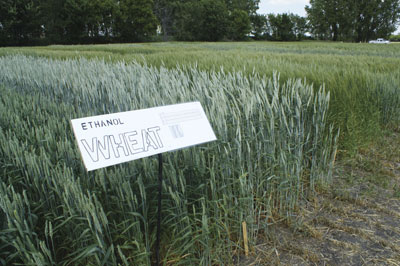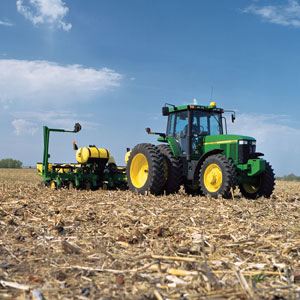
Features
Agronomy
Cereals
Nine new CWRS lines in one year?
Visiting local seed growers and regional crop evaluation sites is a little more important than usual on the 2010 “to-do” list. This is why growers could be in for a surprise.
October 20, 2009 By John Dietz
Visiting local seed growers and regional crop evaluation sites is a little more important than usual on the 2010 “to-do” list. This is why growers could be in for a surprise. The Prairie Grain Development Committee supported applications for a record nine new lines of Canadian Western Red Spring (CWRS) wheat in February 2009. In a sense, these are the “first fruit” of the grower-funded research expansion that began in 1993.

|
|
| The new Canada Western General Purpose class means more crop choices. Photo by John Dietz. |
When he is not worrying about his own crops and seed production, east-central Alberta’s Keith Degenhardt takes the chair for the producer-funded Western Grain Research Foundation (WGRF), representing 18 commodity groups and general farm organizations. The 2009 endorsements were likely a snapshot of things to come, at least for wheat production, Degenhardt says. The past norm of seeing one, two or three new wheat lines in a given year is just that, the past. The future promises many more lines of wheat and new requirements for growers.
The WGRF collects checkoffs from wheat and barley deliveries to the Canadian Wheat Board to support plant breeding development.
At the Prairie Grain Development Committee’s February 2009 meeting in Banff, 25 new wheat lines and one spelt were up for review. Eleven lines were proposed and nine supported for the CWRS class. This single class now contains nearly 60 varieties. Another nine lines were proposed and five supported for an entirely new class, Canada Western General Purpose (CWGP) wheat.
“As you put more dollars into research, you expand the ability of plant breeders to do more processing. They can evaluate a lot more material,” Degenhardt explains. “There’s no question, because of the producer dollars put into the breeding program now, there will be lots of material to evaluate. The Wheat Board checkoff has been cheap to administer and a very economical method for farmers to fund research. “

|
|
| The barley breeding program at Lacombe continues to generate new cultivars. Photo by Bruce Barker. |
Formation of the ninth class of wheat, CWGP, is particularly important. This class, says Degenhardt, represents a great opportunity for plant breeders as well as ethanol and livestock producers. Varieties first designated for the class are Accipiter, CDC Ptarmigan, Minnedosa and Peregrine.
Plant breeders had nine lines already on hand and ready to submit when the CWGP class was opened. They had been bred for other wheat classes, such as CWRW or CPS, and had good yields but did not meet one or more criteria for the intended class.
Protein requirements for other classes have sharply limited the ability to breed for higher yields. There is an inverse relationship between protein and yields. “If protein isn’t a consideration, you should be able to increase yield faster,” Degenhardt explains. “With CWGP, being a new class, we’re going to see an increase in lines for registration. Breeders are starting to tool up for those targets.”
Most approved lines taken to registration will not see commercial release until the start of the 2012 crop year. That is good, because the industry needs time to adjust, Degenhardt says. “Farmers are going to have a wider choice in what type of wheat or barley they want to grow and what way to market it, what they view as being most profitable. They are going to have more choices, and they have to decide which is more profitable.”
Evaluation tools will become critical
A new online instrument was being developed in mid-2009 to aid growers in decision-making among crop variety choices. It may be ready for site visitors at www.westerngrains.com during the winter of 2009/2010. “This program allows you to look at regional trials and co-op trials all across the Prairies, and to pick out your ecological zone. Then you can pick the exact locations you feel are closest to your conditions on your farm. You can then compare the variety performance head-to-head.”
Other options are the Provincial Seed Guides, published in print by the Provincial Agriculture departments and Seed Grower Associations, and also found online. A Manitoba grower, for instance, will want to check out the performance results posted in the Seed Manitoba guide, Seed Manitoba is published annually by the Manitoba Seed Growers Association, Manitoba Agriculture, Food and Rural Initiatives, and the Manitoba Cooperator. It is also available online at www.seedmb.ca.
Several of the new wheat lines supported for registration were already grown in the Manitoba Crop Variety Evaluation Team (McVET) trials in 2009. At five locations in Manitoba, six recently supported varieties were evaluated: four CWRS, one CPS and one CWGP. The newly supported varieties include two wheat midge-tolerant lines and a Clearfield-resistant line. “For producers, it’s opening a new wide range of varieties. In the past 10 years, we have never seen this many new spring wheat varieties supported for registration. For producers, there’s going to be a lot more looking at data, going on summer tours, talking to seed companies and extension professionals, finding what varieties are going to be the best on their own farms,” says Pam de Rocquigny, provincial cereals specialist, at Carman.
| Plenty of new crop varieties coming down the line The Prairie Recommending Committee for Wheat, Rye and Triticale (PRCWRT) recommended 20 new cultivars for registration at the 2009 meetings:
Snowstar, a Canada Western Hard White Spring wheat, was approved to move from interim to full registration. The Prairie Recommending Committee for Oat and Barley (PRCOB) recommended for registration:
The Prairie Recommending Committee for Pulse and Special Crops (PRCPSC) recommended for registration:
The Prairie Recommending Committee for Oilseeds (PRCO) recommended for registration one linseed flax line. |
|